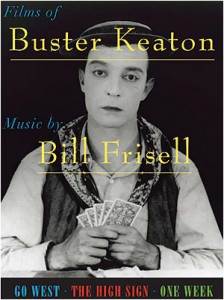By: Evan Desaulnier
 For those of you who may be unfamiliar with the music of Bill Frisell, or maybe more to the point, that you might find it difficult to pinpoint exactly what it is that he does and what genre of music he plays, you’re probably not alone. He is, after all, constantly changing directions in his musical endeavors. From jazz, to American folk and blues, to some combination of the two, his music always manages to bear the stamp of his unique musical voice. On the 2009 release of Films of Buster Keaton by Bill Frisell, the guitarist once again explores new musical territory in his homage to the silent-era films of Buster Keaton.
For those of you who may be unfamiliar with the music of Bill Frisell, or maybe more to the point, that you might find it difficult to pinpoint exactly what it is that he does and what genre of music he plays, you’re probably not alone. He is, after all, constantly changing directions in his musical endeavors. From jazz, to American folk and blues, to some combination of the two, his music always manages to bear the stamp of his unique musical voice. On the 2009 release of Films of Buster Keaton by Bill Frisell, the guitarist once again explores new musical territory in his homage to the silent-era films of Buster Keaton.
As always, Frisell is continuously reinventing the role and place of music in all walks of art. An interesting precedent for this DVD was Frisell’s 2005 release of Richter 858. Here, Frisell richly blended musical compositions for guitar and string quartet with the visual material of a series of paintings by German Artist, Gerhard Richter. The Buster Keaton film project is further evidence of Frisell’s original approach to music and art, in that music and film are harmoniously united to create a larger sensory experience, one that exhibits Frisell’s prowess as not only a boundary-pushing guitar player, but as an innovative composer as well.
In particular, this DVD incorporates the visual of 3 Buster Keaton films of the 1920s – The High Sign, One Week, and Go West – with Frisell’s various projects from the mid-1990s. In 1995, Frisell released two albums for the Nonesuch record label that engendered the musical accompaniment for the three Keaton films in this DVD entitled Go West: Music for the Films of Buster Keaton and The High Sign-One Week: Music for the Films of Buster Keaton.
Now re-recorded and set to the films, one can witness the marriage of Frisell’s musical vision with the genius of Keaton’s slapstick comedy. Frisell is joined by his collaborators from the previous Buster Keaton sessions: bassist, Kermit Driscoll and drummer, Joey Baron. Throughout all three films, the trio ingeniously negotiates Keaton signature physical comedy as well as the films’ dramatic action.
In The High Sign, Keaton’s character is unsuspectingly swept up in an unusual assassination plot with – of course – hilarious results. Frisell’s compositions not only provide key, impeccably timed sound-effects, but they constantly match the feeling and mood of the advancing plotline. For instance, gunshots are matched by rim-shots from Baron, a woman playing a mandolin is echoed by a dark, yet comical parody by Frisell and his looped effects, and of course, the film’s antagonists are met with Frisell’s conception of the quintessential “bad guy” music.
What begins to emerge, then, is a somehow melancholy and brooding musical accompaniment that is steeped with references to musical Americana and traditional blues, and yet in doing so achieves a modernist, contorted sheen that advances the narrative of the films themselves. At every turn Frisell’s fluid, yet meticulously calculated compositional genius shines through to create this dark and beautiful musical landscape. Interestingly though, it is probably more apt to view this work as a throw-back to the days of silent film. Days in which these films were meant to be viewed alongside live musical accompaniment. Here, we have just that, in a sense – although it happens to be through the eyes and ears of the ever-enigmatic Bill Frisell.

Links
Bill Frisell Homepage
The Films of Buster Keaton – Music By Bill Frisell on Amazon